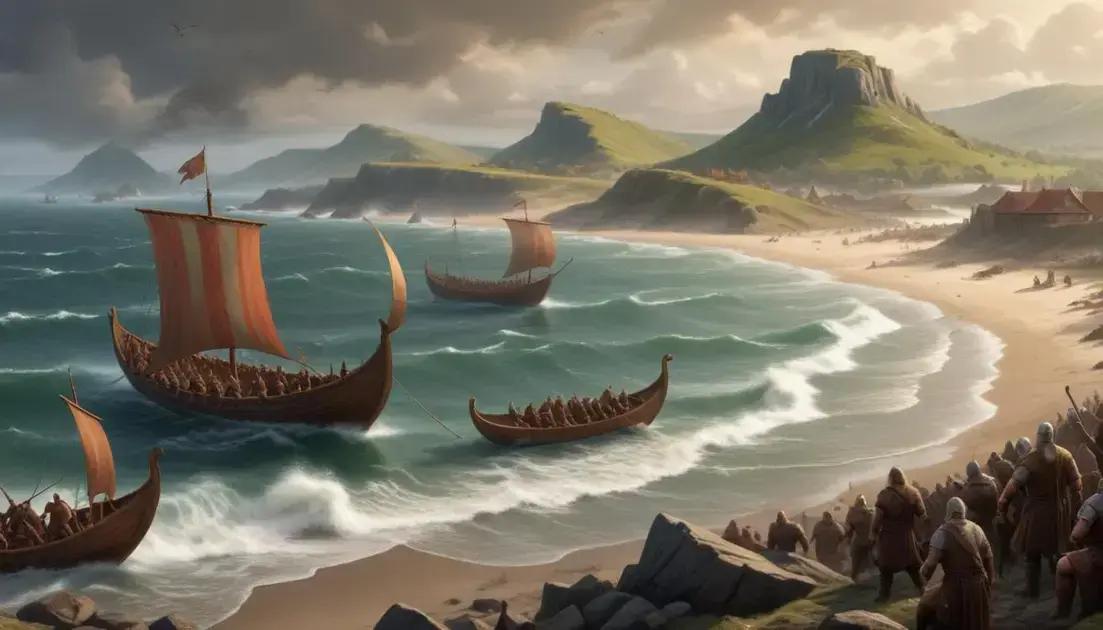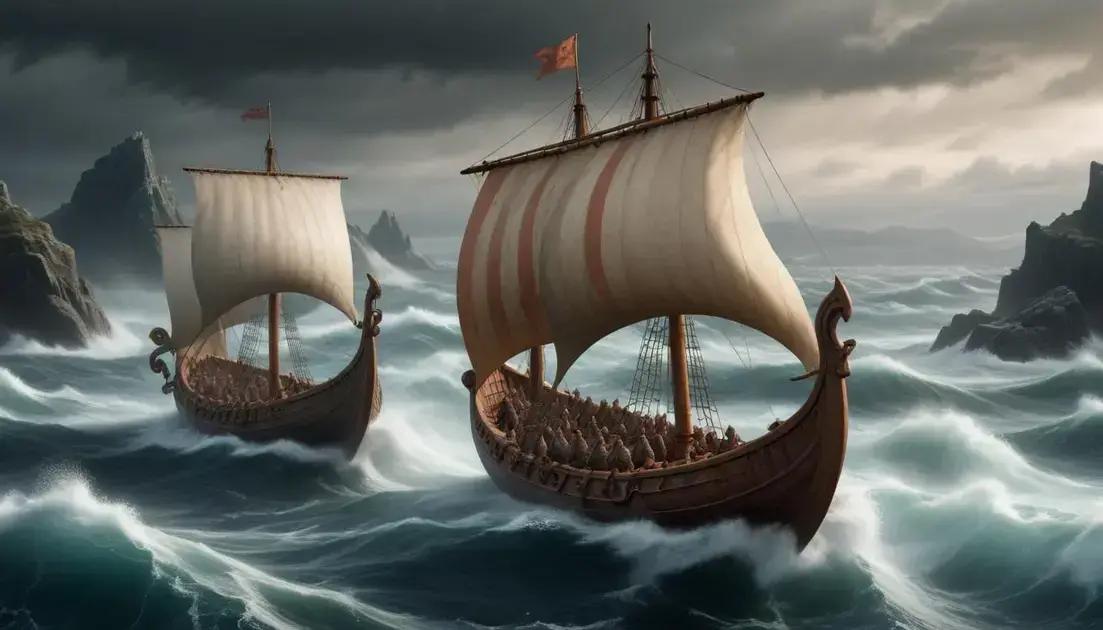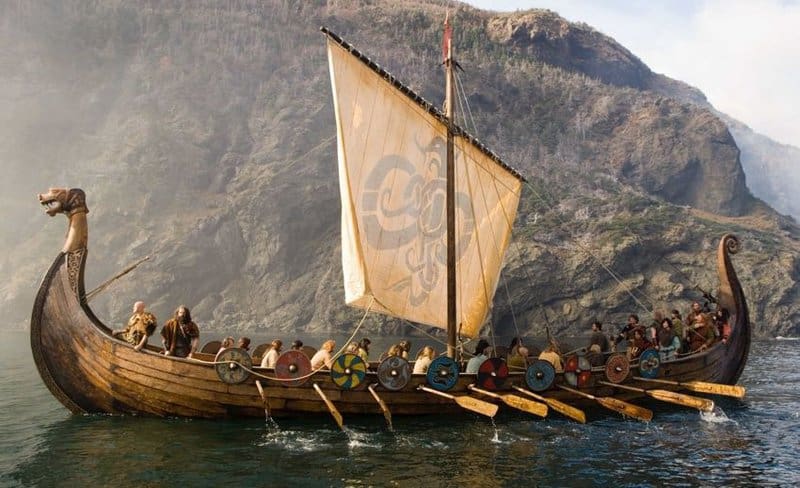
The Viking Raids: How the Norse Changed the Landscape of Europe
The Viking Age (roughly 793-1066 CE) witnessed a period of intense maritime activity by Norsemen, commonly known as Vikings, who launched a series of raids, explorations, and ultimately, settlements across Europe. These actions, though often brutal and destructive, profoundly impacted the social, cultural, political, and economic fabric of Europe, leaving an indelible mark on the continent’s landscape that persists to this day. This in-depth examination will delve into the origins, motivations, methods, consequences, and lasting legacies of the Viking raids, revealing how these Norse seafarers irrevocably altered the course of European history.
I. The Genesis of Viking Expansion: Socioeconomic Pressures in Scandinavia
The Viking raids were not a spontaneous eruption of violence but rather a complex phenomenon rooted in the evolving socioeconomic conditions of Scandinavia during the late 8th and early 9th centuries. While often romanticized as a unified force, the Vikings were not a single entity but rather comprised various groups from present-day Denmark, Norway, and Sweden, each with its own distinct cultural nuances and motivations.
Several factors contributed to their outward expansion:
Population Growth and Resource Scarcity: A growing population in Scandinavia, coupled with limited arable land and diminishing resources, created intense pressure on existing social structures. The traditional subsistence farming methods were struggling to support an expanding population, leading to competition for land and resources, potentially fueling internal conflicts and a drive for external solutions.
The Rise of a Warrior Elite: Scandinavian society was largely stratified, with a warrior elite emerging as prominent figures. These warriors, skilled in combat and seafaring, saw in raiding and conquest an opportunity to accumulate wealth, prestige, and power. The allure of riches and glory motivated many young men to join raiding expeditions, further bolstering the Viking expansion.
Technological Advancements: The Norse possessed advanced shipbuilding techniques, constructing robust, fast, and maneuverable longships. These vessels, capable of navigating shallow waters and rivers, provided unmatched mobility and allowed the Vikings to launch surprise attacks on inland settlements, previously considered safe from maritime incursions. The longships were not merely vessels of war but also served as transport for trade and exploration.
Opportunities for Trade and Exploration: While raiding was certainly a major aspect of Viking activity, trade and exploration also played significant roles. The Norse established extensive trade networks connecting Scandinavia with other parts of Europe, the Middle East, and even the Byzantine Empire. The pursuit of new trade routes and markets incentivized exploration and expansion, often intertwining with raiding activities.
Political Fragmentation and Internal Strife: Scandinavia during this period lacked a centralized political authority. Instead, it was comprised of numerous smaller kingdoms and chiefdoms, often engaged in internal conflicts for power and resources. This political fragmentation may have inadvertently encouraged raiding as a means for individual chieftains to consolidate power and wealth through external conquest.
II. The Methodology of Terror: Tactics and Strategies of Viking Raids
The Vikings’ success stemmed not only from their technological prowess but also from their highly effective raiding tactics:
Surprise Attacks: Their longships allowed them to conduct swift, surprise attacks on unsuspecting settlements. They often struck during the night or during periods of low vigilance, catching their victims completely off guard. The element of surprise was crucial to their success, maximizing their chances of overwhelming the defenses of their targets.
Superior Naval Warfare: The Vikings possessed considerable naval expertise. Their longships were faster and more maneuverable than the ships of their opponents, allowing them to swiftly outmaneuver and outflank enemy forces. Their seamanship and tactical understanding of naval combat gave them a significant advantage.
Brutality as a Weapon: Viking raids were often characterized by brutality and violence. The aim was not merely to plunder but also to instill fear and terror in the local population. The Vikings’ reputation for ruthlessness often led to the quick surrender of settlements, reducing the need for protracted sieges.
Strategic Targeting: The Vikings strategically targeted wealthy monasteries, coastal towns, and undefended settlements. Monasteries, in particular, were attractive targets due to their riches in gold, silver, and other valuables, and their relatively weak defenses. The selection of targets was a calculated strategy to maximize the rewards of the raids.
Effective Communication and Coordination: Despite the decentralized nature of Scandinavian society, Viking raiding expeditions often involved effective communication and coordination. This coordination enabled them to launch large-scale attacks, involving multiple longships and crews, which overwhelmed the defenses of even relatively well-protected settlements.
III. The Impact of the Raids: Transformation of the European Landscape
The Viking raids left an undeniable mark on Europe, triggering significant transformations across various aspects of life:
Economic Disruption: The raids severely disrupted the existing economic systems of Europe. Trade routes were disrupted, commerce declined, and many coastal communities were devastated economically. The constant fear of attack led to investment in fortifications rather than economic development, hindering overall growth.
Fortification and Military Innovation: The Viking raids spurred significant advancements in defensive architecture and military technology. European kingdoms and settlements invested heavily in building stronger fortifications, including stone walls, castles, and fortified towns. Defensive strategies were refined to counteract the swift and effective tactics of the Vikings.
Political Fragmentation and Consolidation: The raids exacerbated the existing political fragmentation in Europe. Smaller kingdoms and principalities struggled to defend themselves against the Vikings, leading to further division and internal conflicts. Conversely, the raids also encouraged the consolidation of power in some regions as rulers sought to create stronger centralized states to resist Viking incursions. The development of feudalism, with its decentralized system of power and emphasis on local defense, can in part be attributed to the challenges posed by the Vikings.
IV. Beyond Raiding: Trade, Settlement, and Cultural Exchange
The Vikings’ activities extended far beyond raiding. They established significant trade networks and eventually established settlements across Europe, contributing to a substantial cultural exchange:
Trade Networks: The Vikings played a pivotal role in expanding trade networks across Europe, connecting Scandinavia with the British Isles, Francia, the Byzantine Empire, and even the Middle East. They traded furs, amber, slaves, timber, and weaponry for silver, gold, silks, and other valuable commodities. This trade facilitated the exchange of ideas, technologies, and cultural practices between different regions.
Settlements and Colonization: The Vikings were not just raiders but also explorers and settlers. They established permanent settlements in Iceland, Greenland, and even reached North America (L’Anse aux Meadows in Newfoundland, Canada). These settlements indicate a long-term strategy beyond simple raiding for immediate gain and highlight their adaptability and navigational skills.
Cultural Exchange and Influence: The interaction between the Vikings and other European populations led to a complex process of cultural exchange. Viking culture, language, and traditions influenced the regions they raided and settled, leaving a lasting impact on local customs, languages, and place names. Conversely, the Vikings also absorbed aspects of the cultures they encountered, demonstrating a degree of cultural assimilation and adaptation.
V. The Decline of Viking Raids and the Legacy of the Norse
The frequency and intensity of Viking raids gradually diminished during the late 10th and early 11th centuries. Several factors contributed to this decline:
Christianization: The conversion of Scandinavia to Christianity led to a decline in raiding, as Christian values emphasized peace and discouraged violence. The Church actively worked against raiding, impacting the social acceptance and moral justification of these activities.
Political Consolidation: The consolidation of power in several European kingdoms strengthened their ability to resist Viking incursions. Stronger centralized states could muster larger and better-equipped armies, effectively repelling Viking attacks.
Internal Conflicts: Increasing internal conflicts within Scandinavia diverted resources and manpower away from raiding activities. The competition for power and resources amongst Scandinavian chieftains weakened their ability to launch large-scale expeditions.
Despite the eventual decline of the raids, the legacy of the Vikings remains profound:
Linguistic Impact: Viking raids and settlements significantly impacted the languages of Europe. Numerous place names, particularly in the British Isles, are derived from Old Norse. The influence of Old Norse on English, Scottish Gaelic, and other languages is still evident today.
Genetic Influence: Genetic studies show that Vikings had a considerable impact on the genetic makeup of populations in various parts of Europe. Their interactions with local populations resulted in a mixing of genes, contributing to the genetic diversity of modern-day European populations.
Cultural Legacy: The Viking legacy is reflected in various aspects of European culture, including mythology, literature, art, and architecture. Their stories and sagas have influenced European literature and folklore for centuries. Their artistic and craft traditions left their mark on the artistic landscape of the era, visible in metalwork, jewelry, and architecture.
VI. Conclusion: A Complex and Enduring Legacy
The Viking raids were a multifaceted phenomenon, encompassing violence, exploration, trade, and cultural exchange. While often remembered for their brutality, the Vikings were more than just ruthless raiders. They were skilled navigators, traders, explorers, and settlers who significantly impacted the development of Europe. Their influence is visible in the languages we speak, the genes we carry, and the cultural traditions that persist to this day. The Viking Age remains a compelling and complex chapter in European history, a testament to the transformative power of human interaction and the enduring legacies of past civilizations. Studying this era compels us to engage with the complexity of history, acknowledging both the destructive and constructive aspects of human interaction across cultures and time periods. The Vikings’ legacy, though forged in violence and expansion, serves as a reminder of the dynamic and often unpredictable forces that have shaped the world we inhabit.


